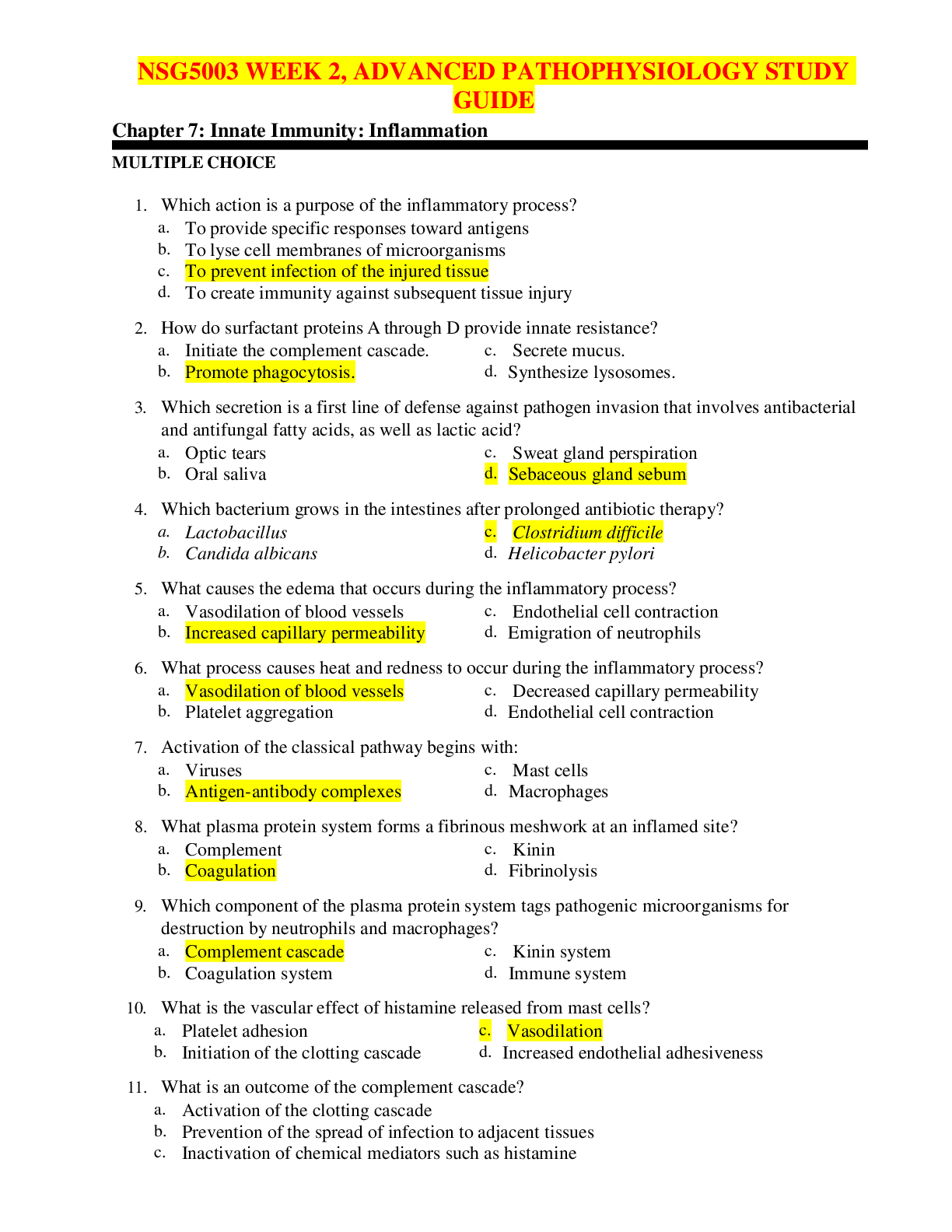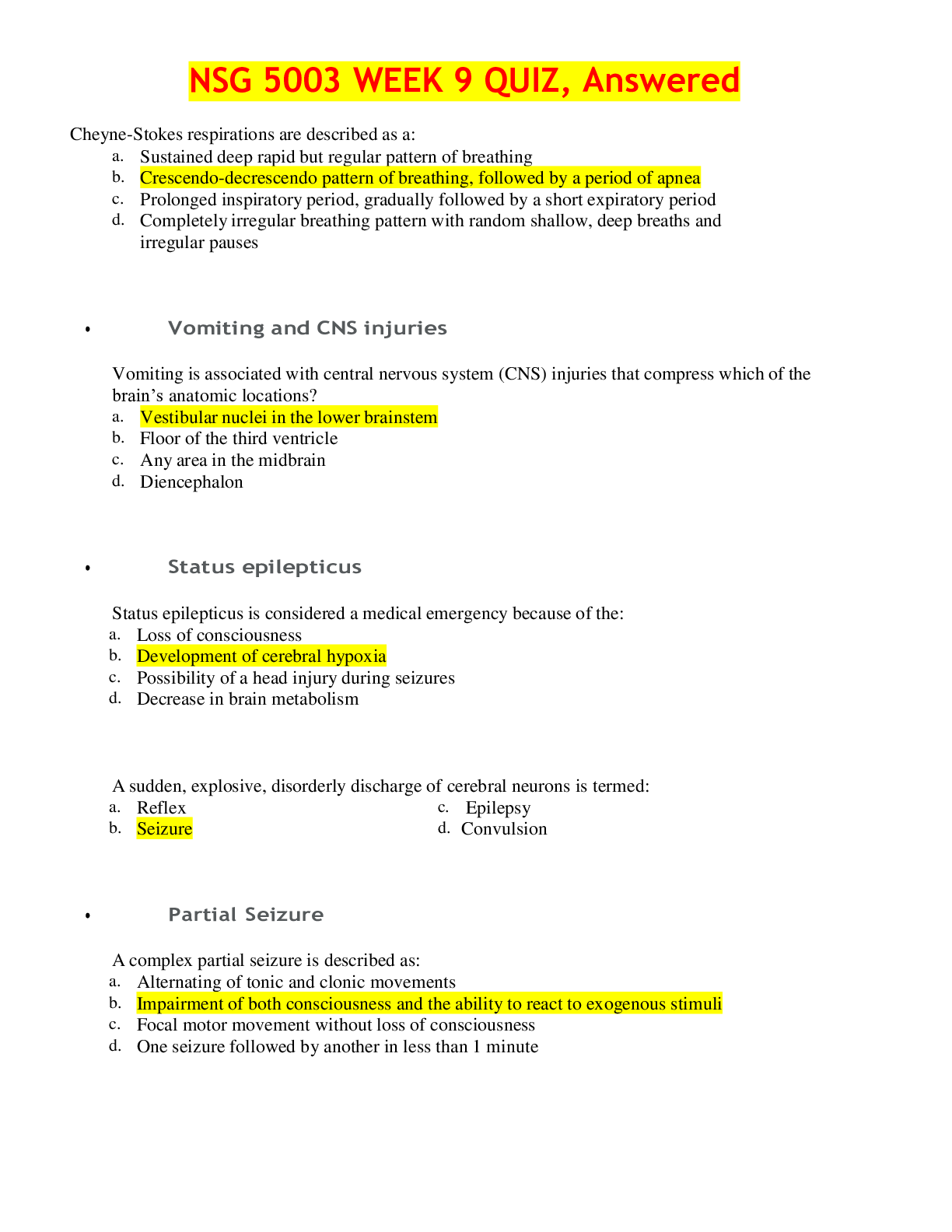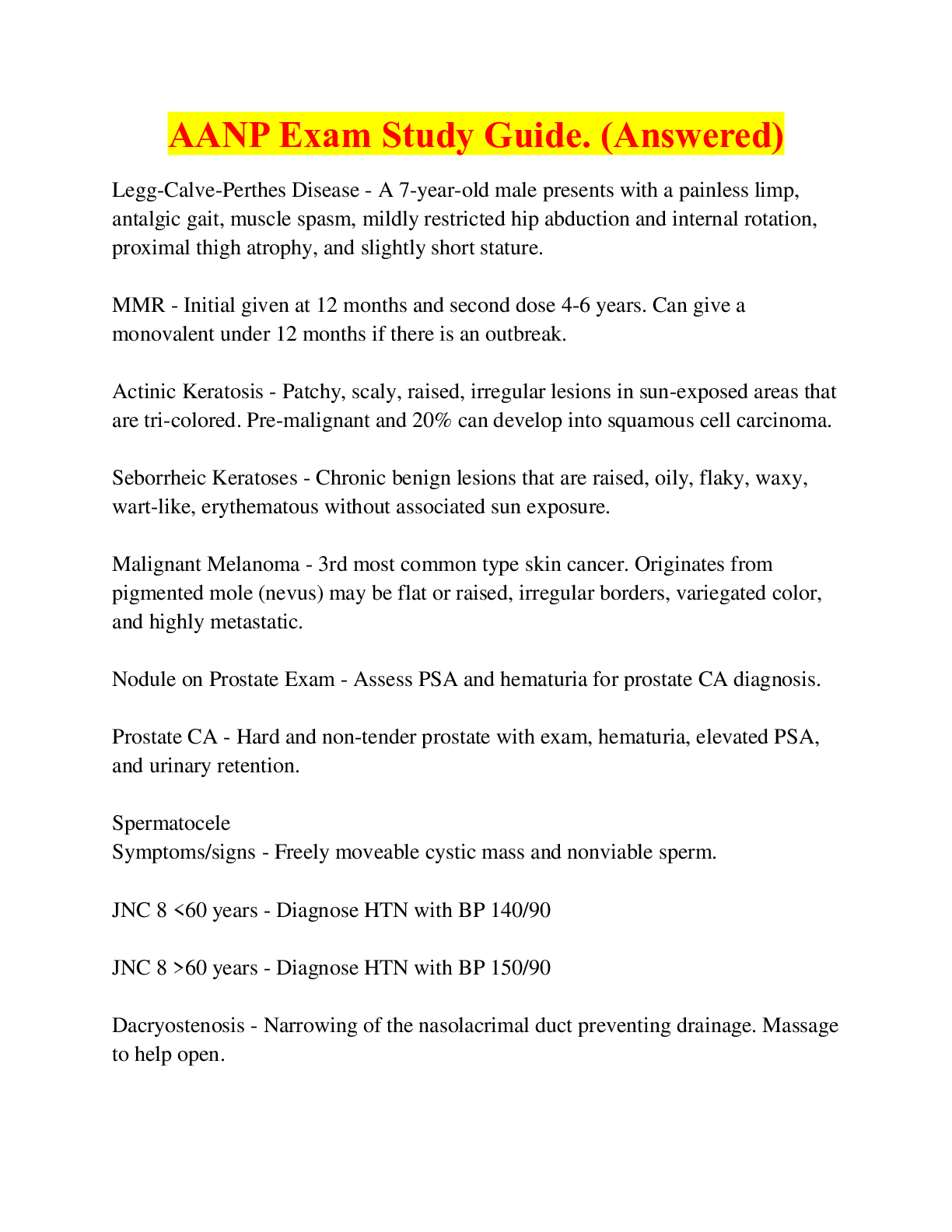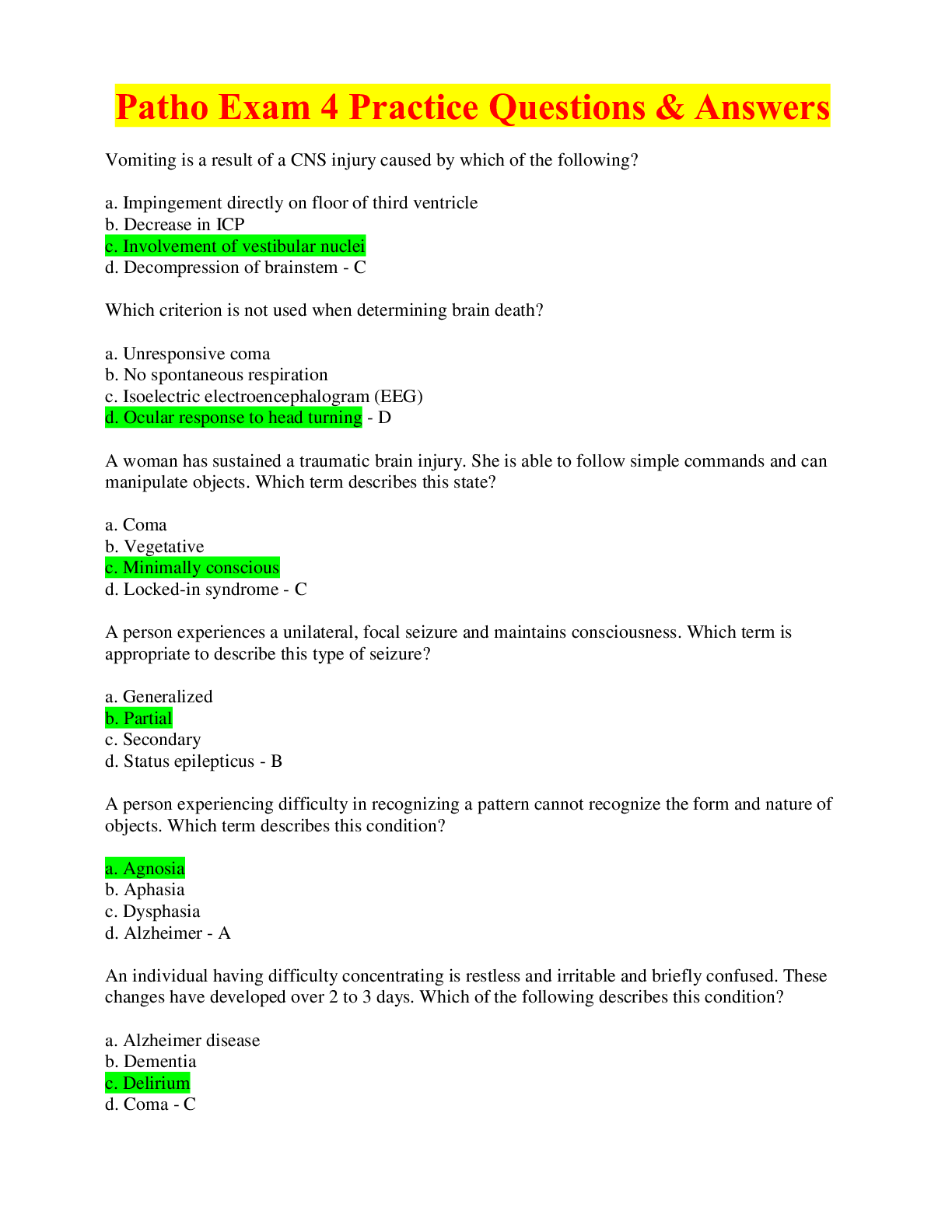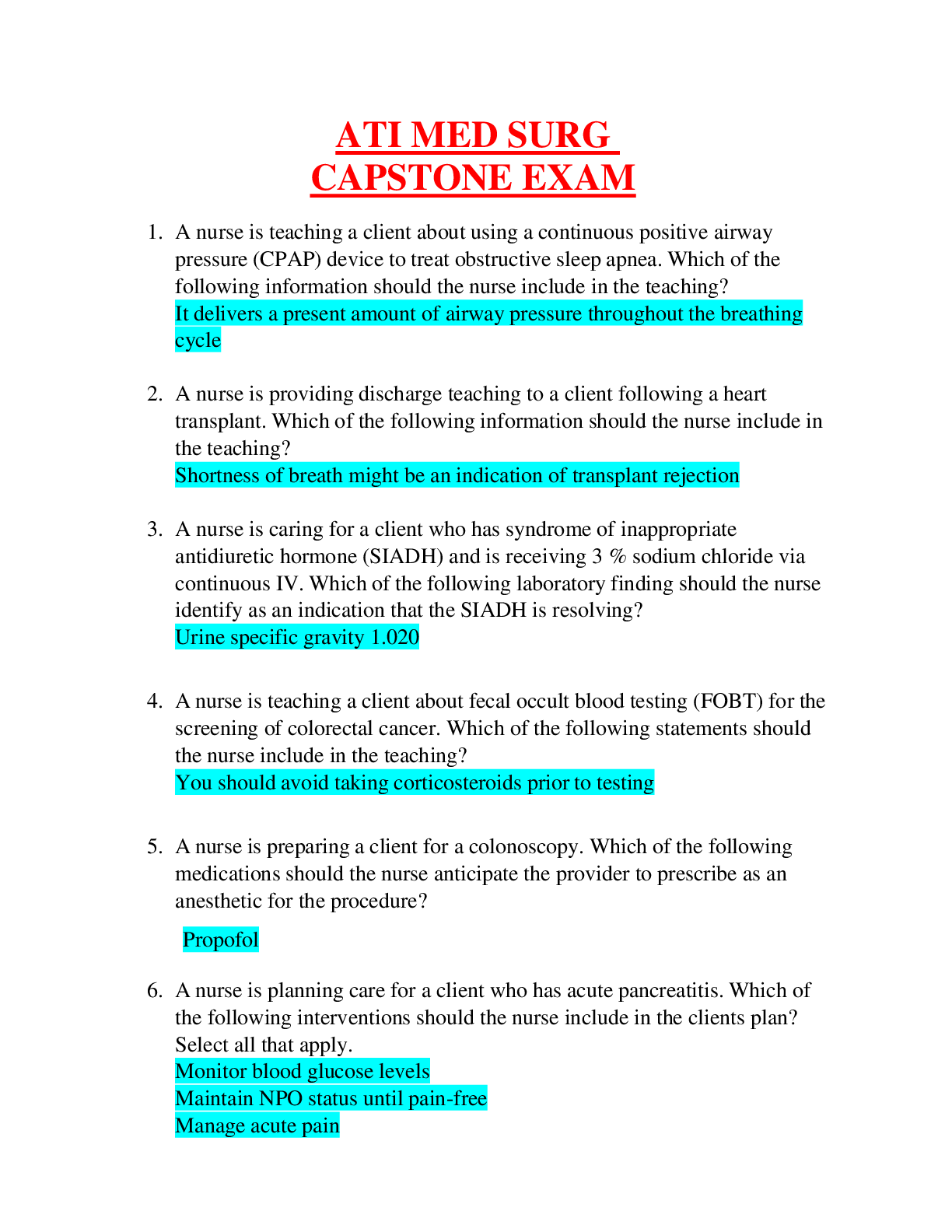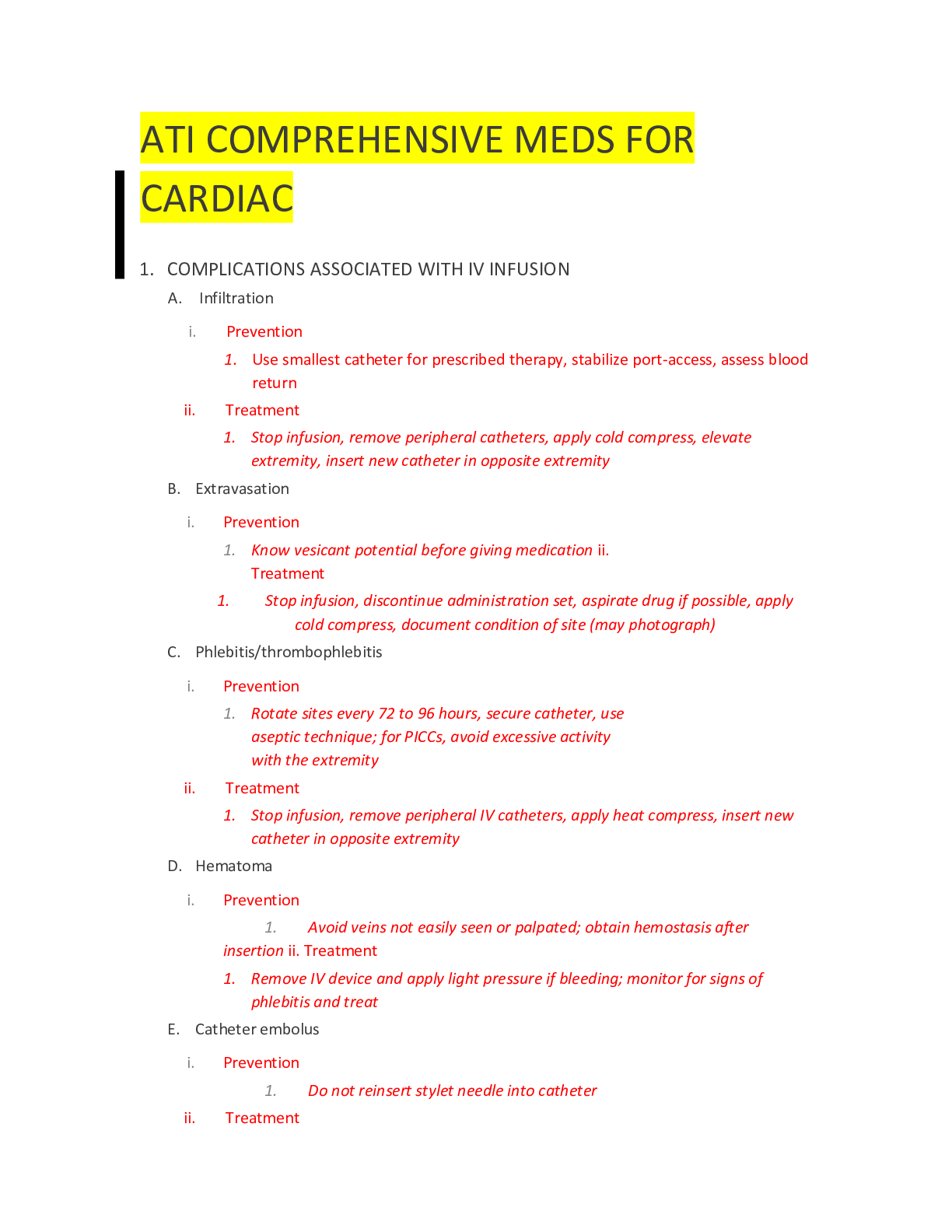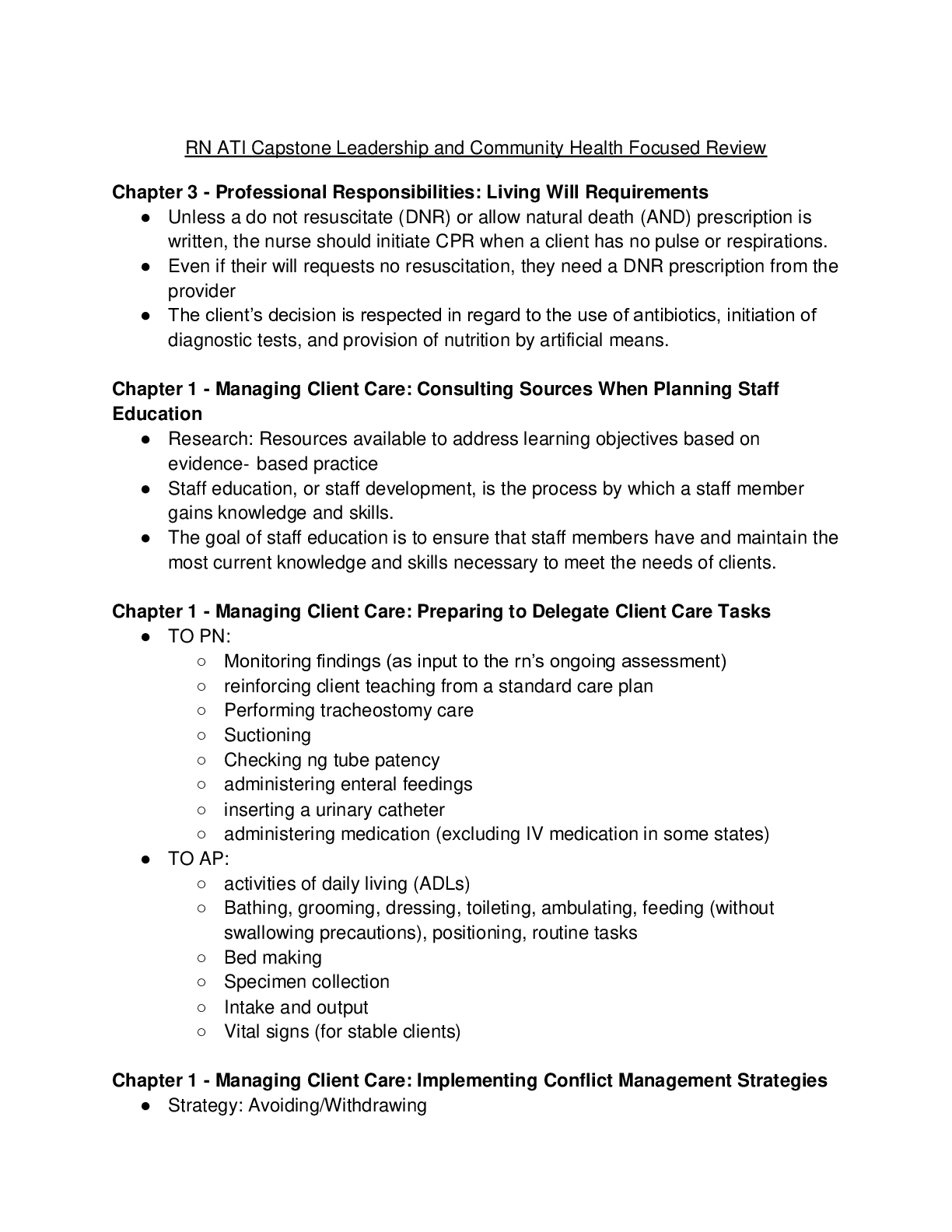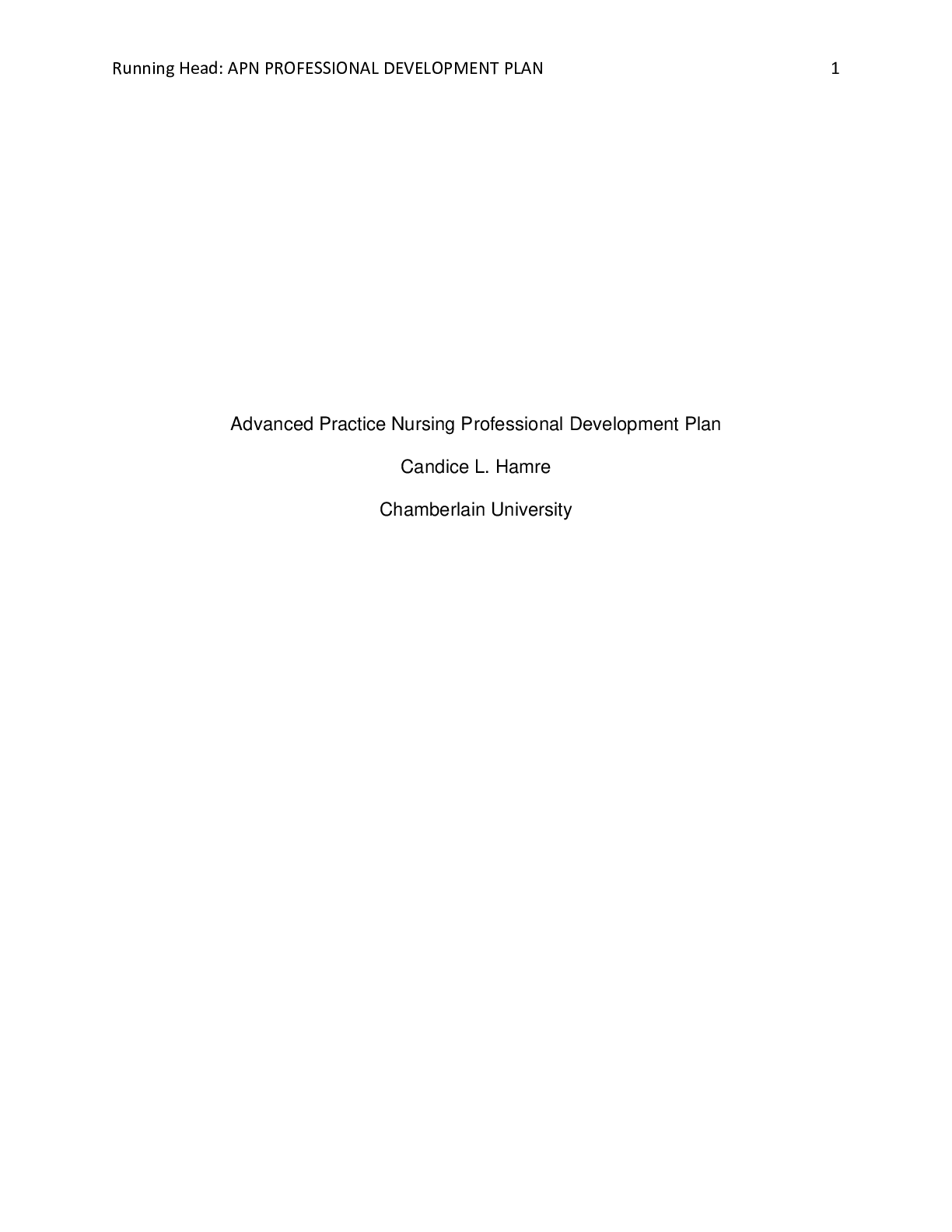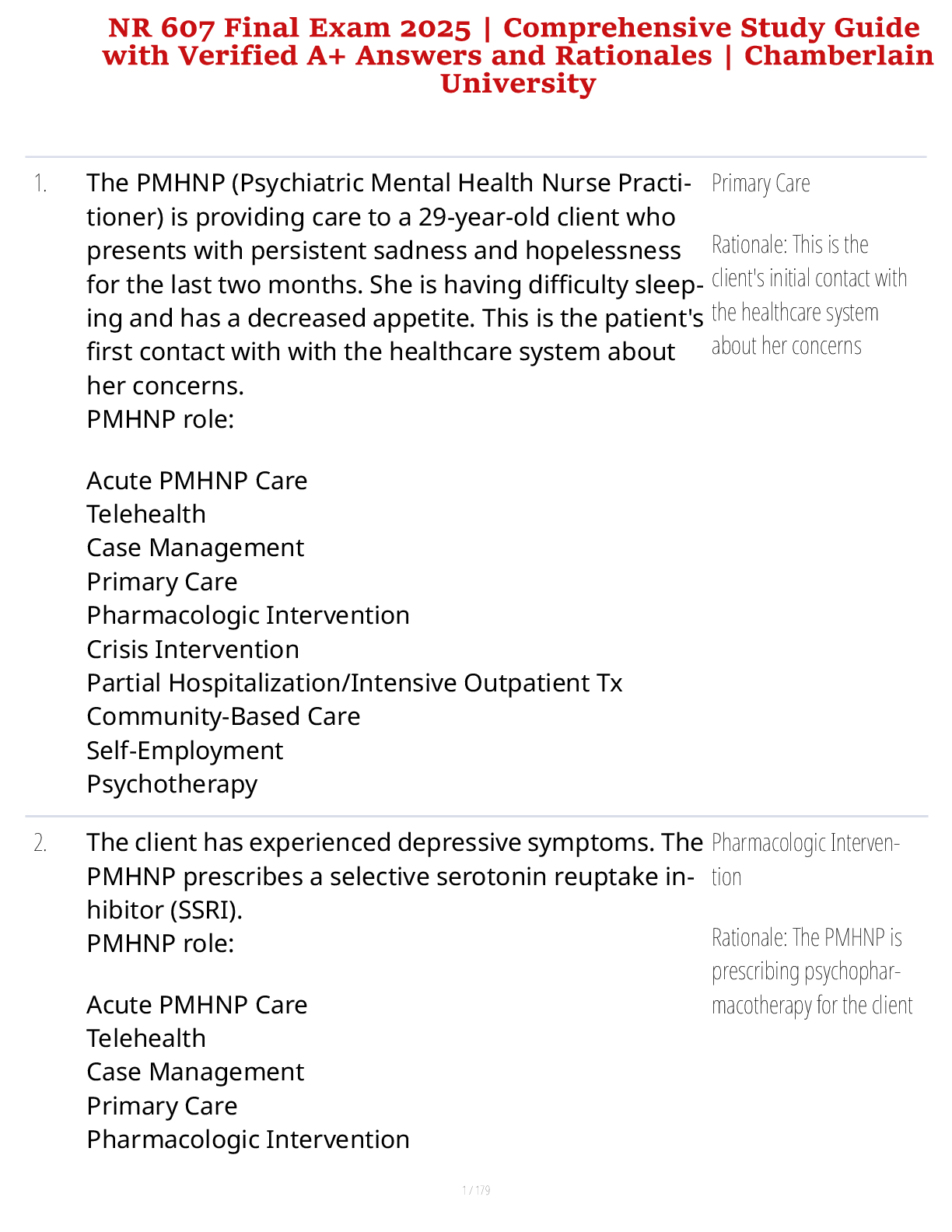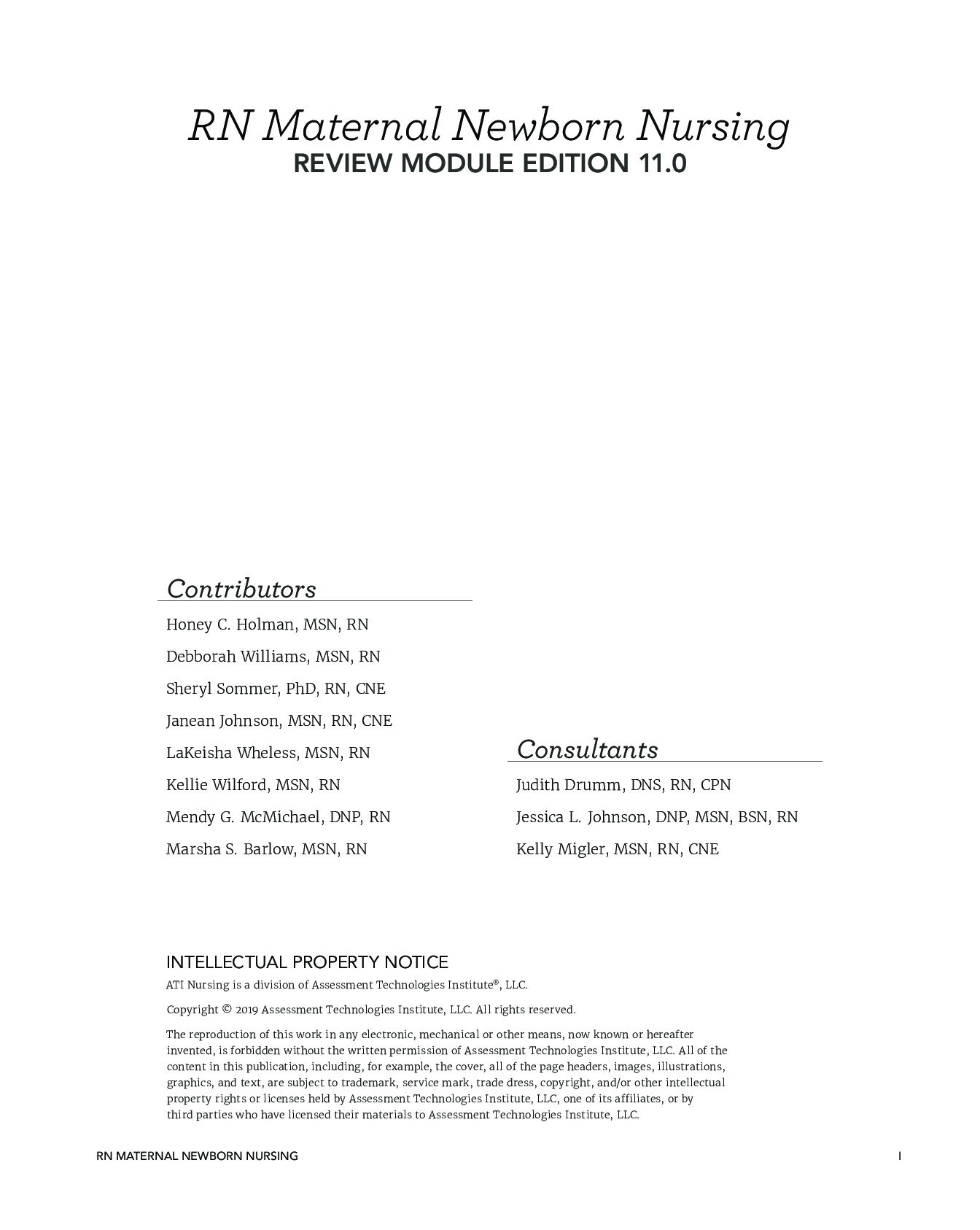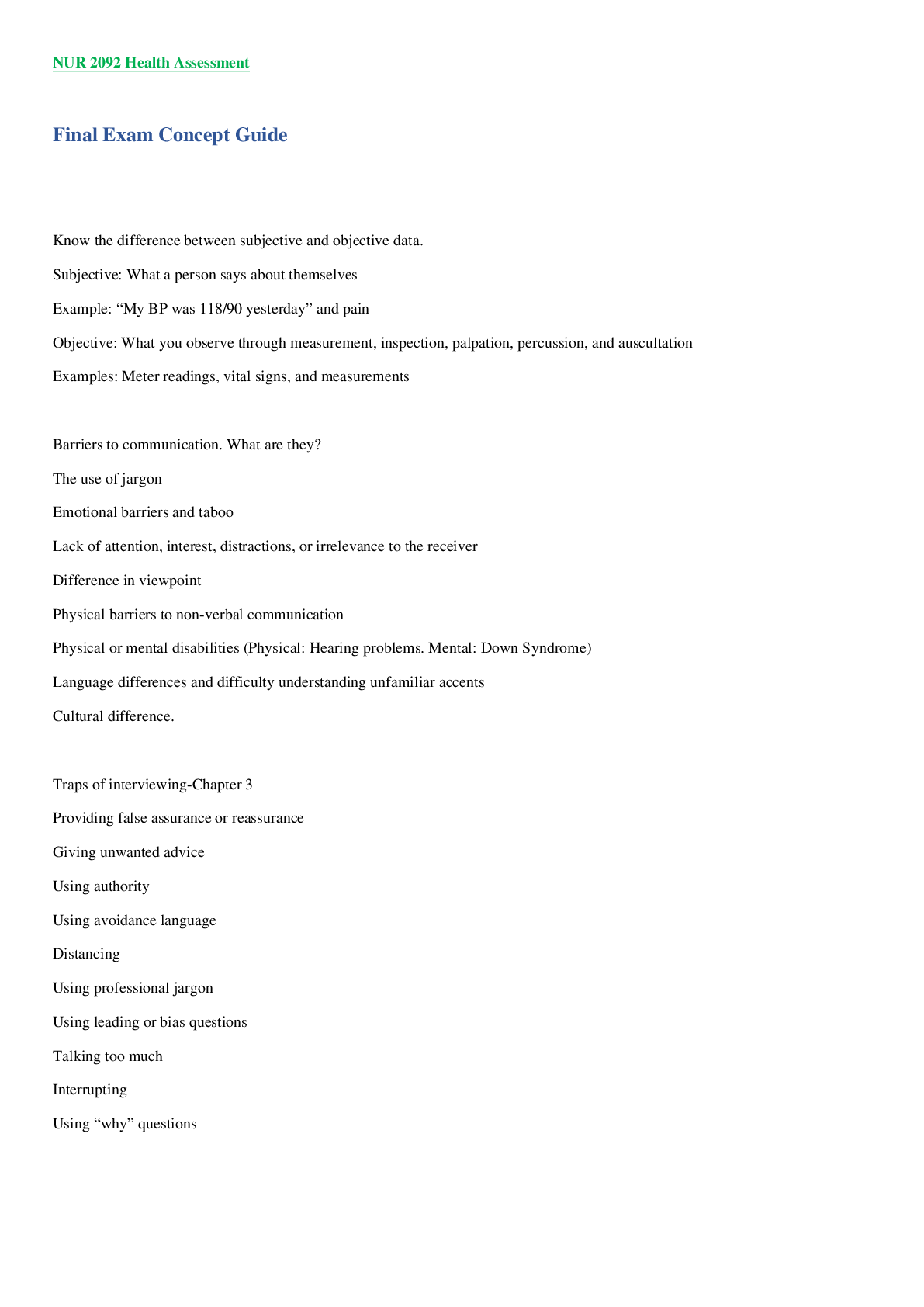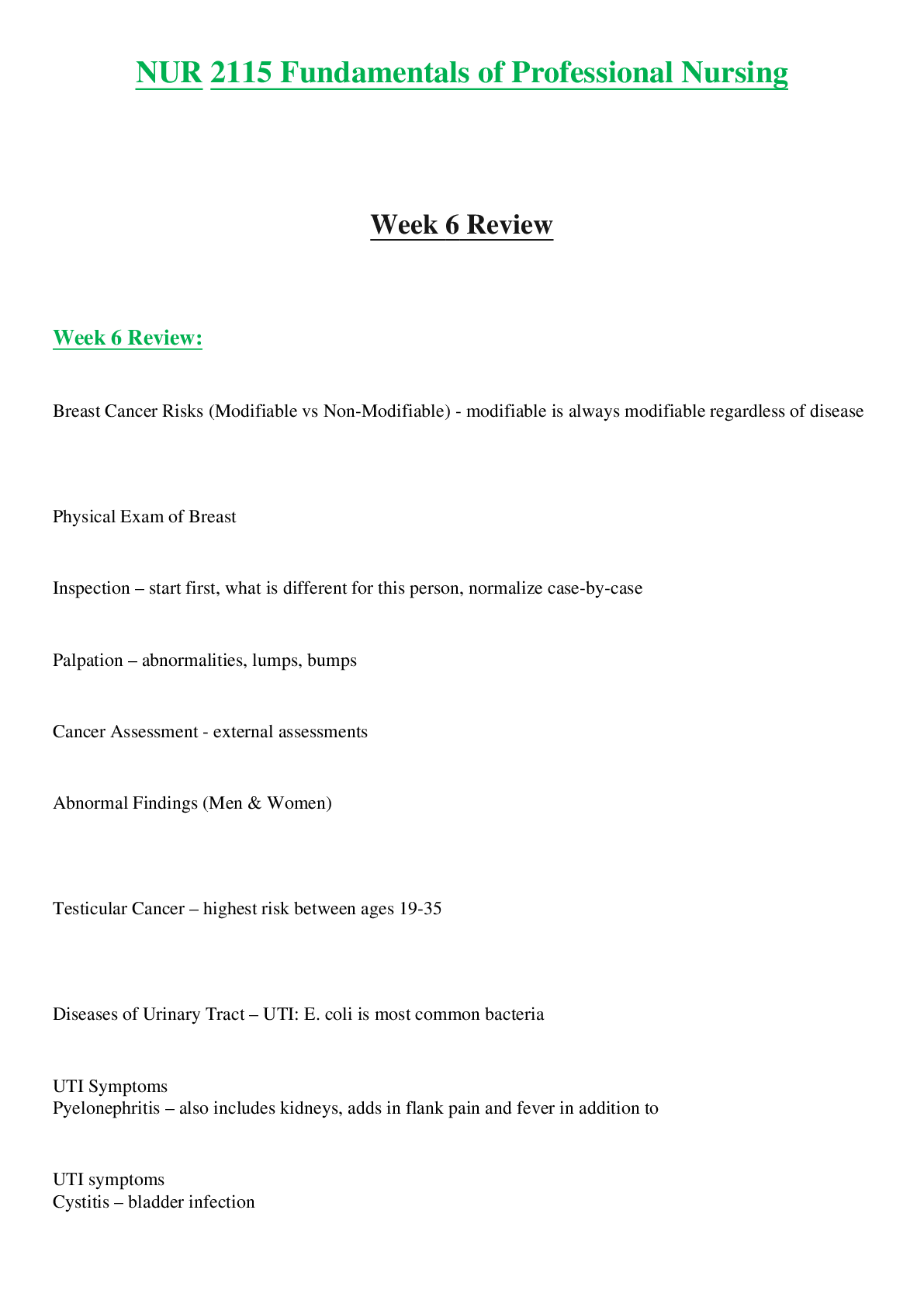NSG5003 WEEK 2, ADVANCED PATHOPHYSIOLOGY STUDY GUIDE
Document Content and Description Below
NSG5003 WEEK 2, ADVANCED PATHOPHYSIOLOGY STUDY GUIDE-1. Which action is a purpose of the inflammatory process?
a. To provide specific responses toward antigens
b. To lyse cell membranes of microorga
...
nisms
c. To prevent infection of the injured tissue
d. To create immunity against subsequent tissue injury
2. How do surfactant proteins A through D provide innate resistance?
a. Initiate the complement cascade. c. Secrete mucus.
b. Promote phagocytosis. d. Synthesize lysosomes.
3. Which secretion is a first line of defense against pathogen invasion that involves antibacterial and antifungal fatty acids, as well as lactic acid?
a. Optic tears c. Sweat gland perspiration
b. Oral saliva d. Sebaceous gland sebum
4. Which bacterium grows in the intestines after prolonged antibiotic therapy?
a. Lactobacillus c. Clostridium difficile
b. Candida albicans d. Helicobacter pylori
5. What causes the edema that occurs during the inflammatory process?
a. Vasodilation of blood vessels c. Endothelial cell contraction
b. Increased capillary permeability d. Emigration of neutrophils
6. What process causes heat and redness to occur during the inflammatory process?
a. Vasodilation of blood vessels c. Decreased capillary permeability
b. Platelet aggregation d. Endothelial cell contraction
7. Activation of the classical pathway begins with:
a. Viruses c. Mast cells
b. Antigen-antibody complexes d. Macrophages
8. What plasma protein system forms a fibrinous meshwork at an inflamed site?
a. Complement c. Kinin
b. Coagulation d. Fibrinolysis
9. Which component of the plasma protein system tags pathogenic microorganisms for destruction by neutrophils and macrophages?
a. Complement cascade c. Kinin system
b. Coagulation system d. Immune system
10. What is the vascular effect of histamine released from mast cells?
a. Platelet adhesion c. Vasodilation
b. Initiation of the clotting cascade d. Increased endothelial adhesiveness
11. What is an outcome of the complement cascade?
a. Activation of the clotting cascade
b. Prevention of the spread of infection to adjacent tissues
c. Inactivation of chemical mediators such as histamine
d. Lysis of bacterial cell membranes
12. The function of opsonization related to the complement cascade is to:
a. Tag of pathogenic microorganisms for destruction by neutrophils and macrophages.
b. Process pathogenic microorganisms so that activated lymphocytes can be created
for acquired immunity.
c. Destroy glycoprotein cell membranes of pathogenic microorganisms.
d. Promote anaphylatoxic activity, resulting in mast cell degranulation.
13. In the coagulation (clotting) cascade, the intrinsic and the extrinsic pathways converge at which factor?
a. XII c. X
b. VII d. V
14. Which chemical interacts among all plasma protein systems by degrading blood clots, activating complement, and activating the Hageman factor?
a. Kallikrein c. Bradykinin
b. Histamine d. Plasmin
15. The chemotactic factor affects the inflammatory process by:
a. Causing vasodilation around the inflamed area
b. Stimulating smooth muscle contraction in the inflamed area
c. Directing leukocytes to the inflamed area
d. Producing edema around the inflamed area
16. What affect does the process of histamine binding to the histamine-2 (H2) receptor have on inflammation?
a. Inhibition c. Acceleration
b. Activation d. Termination
17. Frequently when H1 and H2 receptors are located on the same cells, they act in what fashion?
a. Synergistically c. Antagonistically
b. Additively d. Agonistically
18. Some older adults have impaired inflammation and wound healing because of which problem?
a. Circulatory system cannot adequately perfuse tissues.
b. Complement and chemotaxis are deficient.
c. Underlying chronic illness(es) exists.
d. Number of mast cells is insufficient.
19. Which chemical mediator derived from mast cells retracts endothelial cells to increase vascular permeability and to cause leukocyte adhesion to endothelial cells?
a. Leukotrienes c. Platelet-activating factor
b. Prostaglandin E d. Bradykinin
20. What is the inflammatory effect of nitric oxide (NO)?
a. Increases capillary permeability, and causes pain.
b. Increases neutrophil chemotaxis and platelet aggregation.
c. Causes smooth muscle contraction and fever.
d. Decreases mast cell function, and decreases platelet aggregation.
21. What is the correct sequence in phagocytosis?
a. Engulfment, recognition, fusion, destruction
b. Fusion, engulfment, recognition, destruction
c. Recognition, engulfment, fusion, destruction
d. Engulfment, fusion, recognition, destruction
22. When considering white blood cell differentials, acute inflammatory reactions are related to elevations of which leukocyte?
a. Monocytes c. Neutrophils
b. Eosinophils d. Basophils
23. In the later stages of an inflammatory response, which phagocytic cell is predominant?
a. Neutrophils c. Chemokines
b. Monocytes d. Eosinophils
24. In regulating vascular mediators released from mast cells, the role of eosinophils is to release:
a. Arylsulfatase B, which stimulates the formation of B lymphocytes
b. Histaminase, which limits the effects of histamine during acute inflammation
c. Lysosomal enzymes, which activate mast cell degranulation during acute inflammation
d. Immunoglobulin E, which defends the body against parasites
25. What is the role of a natural killer (NK) cells?
a. Initiation of the complement cascade
b. Elimination of malignant cells
c. Binding tightly to antigens
d. Proliferation after immunization with antigen
26. Which cytokine is produced and released from virally infected host cells?
a. IL-1 c. TNF-
b. IL-10 d. IFN-
27. IFN- is secreted from which cells?
a. Virally infected cells c. Macrophages
b. Bacterial infected cells d. Mast cells
28. Which manifestation of inflammation is systemic?
a. Formation of exudat
[Show More]
Last updated: 11 months ago
Preview 1 out of 18 pages



